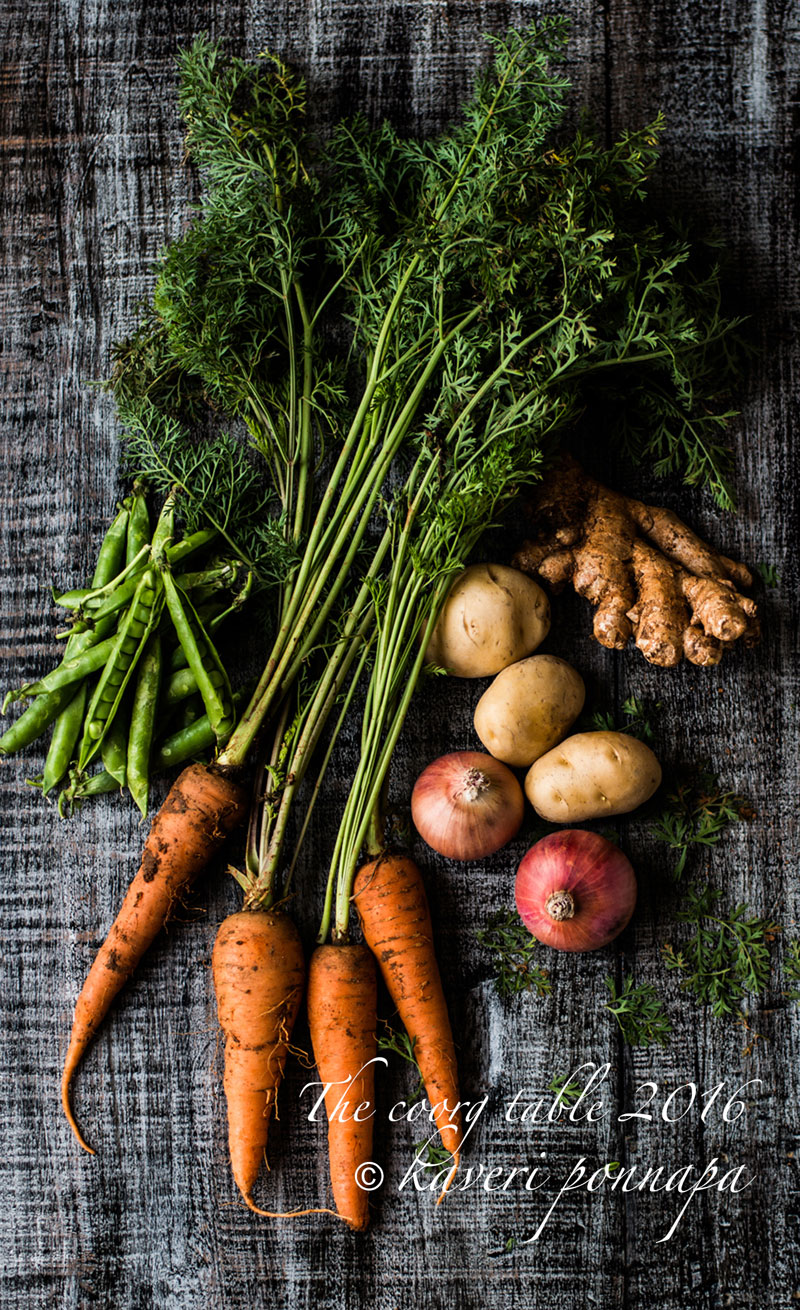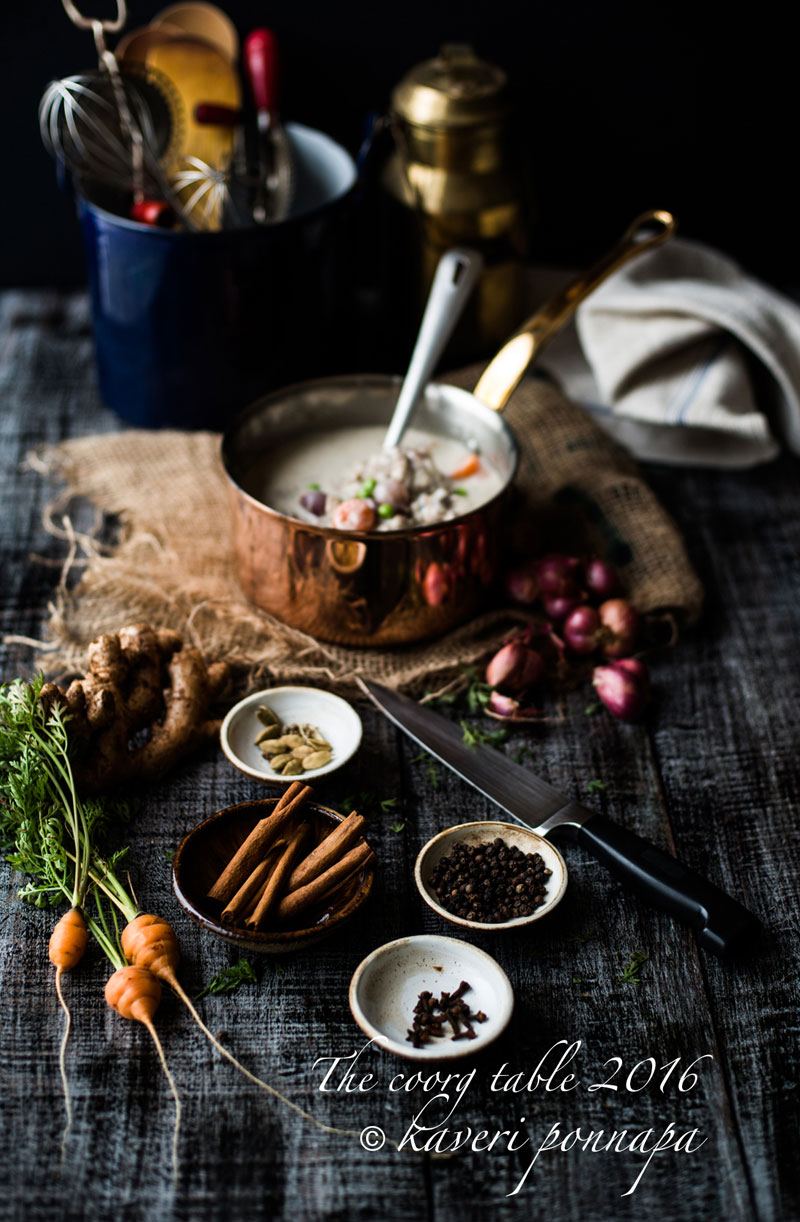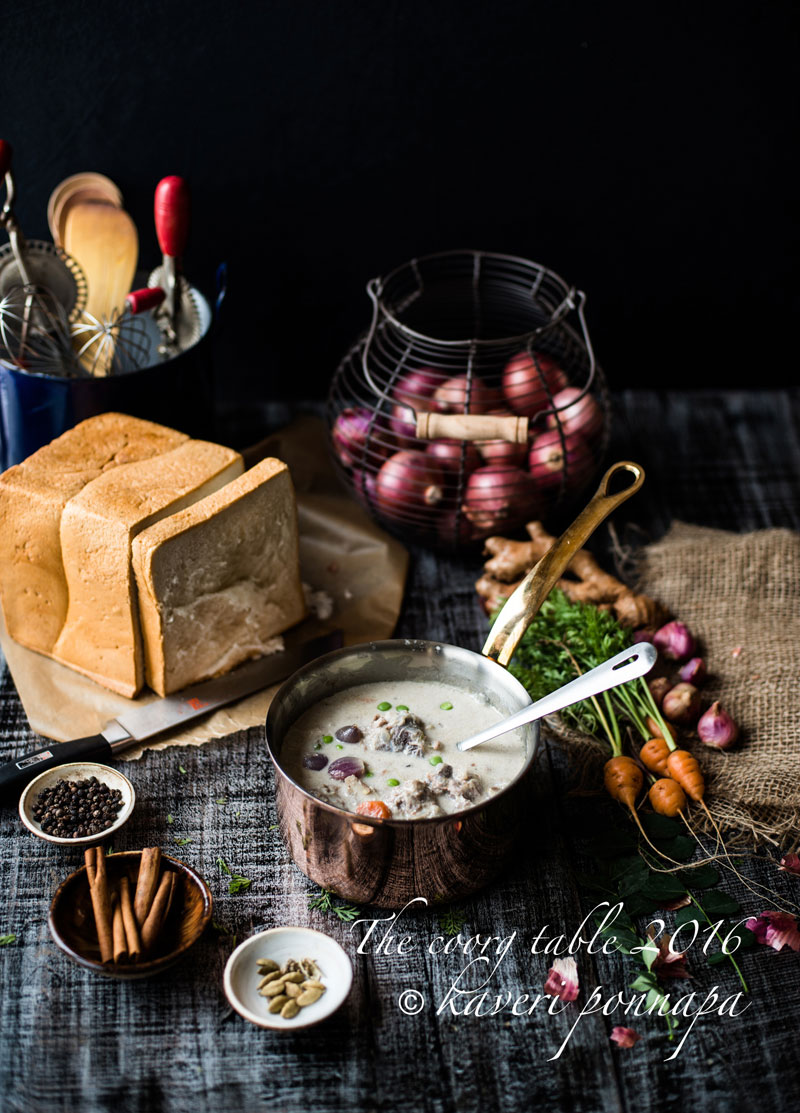The stew that we were served at my boarding school was simply repulsive. It was brown (ish), slippery, and sounded exactly like a description of stews made by local cooks for the British in 19th century India: “lumps of hard meat floating in a greasy, dark gravy, with a few underdone onions and potatoes swimming around!” It was so unlike the pale, smooth, fragrant dish my grandmother made, which went by the same name and raised my expectations, it made me want to weep. I ate as little of it as I could, pushing it around on my plate, dreaming of when I could taste my grandmother’s stew again, full of bright vegetables – carrots and peas –creamy potatoes, soft chunks of meat and best of all, small, domed onions that you ate sliding off layer after beautifully fitted layer, loving their sweetness and slight crunchiness.  Mutton stew was usually served at dinnertime on cold Madikeri nights, with large, chunky, very fresh slices of bread from the local bakery that had been bought the same evening. Madikeri was then a tiny hill town that closed down by 8 pm. On the open front verandah, you could breathe in the cold, clear air and gaze at the shiny darkness of the hills splintered with lights that faded out one by one. The lane that ran behind the house beyond the wood fired kitchen and backyard always rested in deep silence at this time. You knew exactly when the lone motorcycle that belonged to a neighbour would putter up the steep slope, close to 10 pm, a scandalously late hour in a quiet hill town. Erachi stew was wonderful, rich with coconut milk and warm with a handful of aromatic spices. You ate it with your fingers, tearing off chunks of bread and dipping it into the gravy, scooping up everything into your mouth, relishing every little bit on your plate. You could mash the wedges of potato into the creamy gravy for an extra treat. Even as children, we were well aware that it was not a typical Coorg dish – but it had been around for long enough for it to be unremarkable that it was on the table.
Mutton stew was usually served at dinnertime on cold Madikeri nights, with large, chunky, very fresh slices of bread from the local bakery that had been bought the same evening. Madikeri was then a tiny hill town that closed down by 8 pm. On the open front verandah, you could breathe in the cold, clear air and gaze at the shiny darkness of the hills splintered with lights that faded out one by one. The lane that ran behind the house beyond the wood fired kitchen and backyard always rested in deep silence at this time. You knew exactly when the lone motorcycle that belonged to a neighbour would putter up the steep slope, close to 10 pm, a scandalously late hour in a quiet hill town. Erachi stew was wonderful, rich with coconut milk and warm with a handful of aromatic spices. You ate it with your fingers, tearing off chunks of bread and dipping it into the gravy, scooping up everything into your mouth, relishing every little bit on your plate. You could mash the wedges of potato into the creamy gravy for an extra treat. Even as children, we were well aware that it was not a typical Coorg dish – but it had been around for long enough for it to be unremarkable that it was on the table. 
How erachi stew came to our tables is a bit of culinary and historical guesswork – for as many people I know that eat it, an equal number do not. Some of them, like my aunt, always ate it with paputtus or noolputtus, a familiar combination with an older generation, while I can only remember those slices of soft bread, and the familiarity and ease with which my grandmother cooked stew. It was also one of the few dishes that she really enjoyed eating herself.
Food travelled the world with all kinds of companions: traders, conquering armies, explorers and missionaries. From what was foreign, alien, exotic or just plain stomach turning, we tasted, selected – and sometimes made dishes our own. The Irish are famous for their mutton stew, slow – cooked, deepened with root vegetables. I am willing to guess that this dish, with its wonderful mélange of flavours, which I ate on my grandmother’s table, traced its lineage back, however tenuously, to Irish stew. There are enough such hybrid dishes that are a result of the food British colonists brought with them and then took back again, enriched by their encounter with India: kedgeree from khichri; mulligatawny from mullaga thanni and of course, curry. The British ruled the small state of Coorg for just over a century, and although the cuisine remained, for the most part, decidedly traditional, new dishes and cooking techniques were noticed with interest, and adapted to suit local tastes. Kerala’s Mapilah and Syrian Christian ishtew is cooked in kitchens not too distant from our own, with similar flavours. On the West coast, again a short distance from Coorg, Mangalorean stew is near identical, while the Anglo-Indian and East Indian communities use a roux of flour and water as a thickener instead of coconut. In every one of these kitchens, the use of spices and local ingredients transforms the dish into something quite different from the original, until all that appears to be left in common after a while is the name. So while this is not an old-style Coorg, Kerala or Mangalorean dish in the strict sense, it has been adapted and cooked long enough for it to fit in and belong. How do we decide which new foods we keep and which we simply ignore? Which spices to use, in what proportions and combinations? Who decided that mutton stew was worth keeping, and then went about changing most of the essential ingredients, creating something new, retaining the name, but making something closer to a traditional curry in its use of spices? The Dutch, the Portuguese and the British all carried away with them different ideas of what made a curry, twisting and turning ingredients and techniques to suit their own tastes. The first recipe for curry in English was hardly a curry at all, as food historian Alan Davidson has observed. It carried instructions for an English stew instead, with a little rice in it. Curry did not look back after that hesitant start in its adopted homeland. Britain has chosen it as the National Dish, and the country celebrates National Curry Week. Meanwhile, in our kitchens, erachi stew has not changed much. You can eat it with puttus or bread –it is still the perfect thing for a cold night.
Kerala’s Mapilah and Syrian Christian ishtew is cooked in kitchens not too distant from our own, with similar flavours. On the West coast, again a short distance from Coorg, Mangalorean stew is near identical, while the Anglo-Indian and East Indian communities use a roux of flour and water as a thickener instead of coconut. In every one of these kitchens, the use of spices and local ingredients transforms the dish into something quite different from the original, until all that appears to be left in common after a while is the name. So while this is not an old-style Coorg, Kerala or Mangalorean dish in the strict sense, it has been adapted and cooked long enough for it to fit in and belong. How do we decide which new foods we keep and which we simply ignore? Which spices to use, in what proportions and combinations? Who decided that mutton stew was worth keeping, and then went about changing most of the essential ingredients, creating something new, retaining the name, but making something closer to a traditional curry in its use of spices? The Dutch, the Portuguese and the British all carried away with them different ideas of what made a curry, twisting and turning ingredients and techniques to suit their own tastes. The first recipe for curry in English was hardly a curry at all, as food historian Alan Davidson has observed. It carried instructions for an English stew instead, with a little rice in it. Curry did not look back after that hesitant start in its adopted homeland. Britain has chosen it as the National Dish, and the country celebrates National Curry Week. Meanwhile, in our kitchens, erachi stew has not changed much. You can eat it with puttus or bread –it is still the perfect thing for a cold night. 
Photo Credits: Nithin Sagi
All Food Styling: Kaveri Ponnapa
Please look out for this recipe in my upcoming cookbook.
Thank you for visiting this page. If you read something that you enjoy, or see an image that you like, please take a moment to write a response. Do look out for the recipes of all the food featured here in my upcoming cookbook.





Hello kaveri I hope you put some of your recipes on this page
Hi Reshma, welcome to The Coorg Table! All the recipes for the posts here, and many more, are going into a cookbook that I am working on. Do look out for it, and for new posts too. Best wishes. Kaveri
Wonderfully written! Really enjoy reading your blog posts and look forward to getting your book once it is published! Hope it will be available overseas too! 🙂
Hello Kartik, thank you so much, I’m very glad that you enjoy the posts here. Do keep reading, and look out for the cookbook. Yes, I am sure there will be a way to get it overseas too. Best wishes.Kaveri
Very nicely written..I have never seen erachi with vegetables it’s quite different…Hope there will be lot of surprises in your up coming book for which we are eagerly waiting…thanks for sharing all the beautiful stories behind dishes….
Hi Kaverappa, yes, there are going to be some great recipes in the book-I hope you will enjoy them all, at least the vegetarian ones! Do keep reading these pages. Warm wishes.Kaveri.
My ma was good in making Coorg stews and me..her son am pretty good too. Some day I will treat u to “flavours of Coorg stews in Puducherry.” Thank Q Kaveri
Hi Krishna, thank you very much for the kind offer, I look forward to trying your version of stew someday. Do keep reading these pages, and write in when you can. Best wishes. Kaveri.
Those cutleries are to die for !!!! Where did you get these beauties from ???
Hello Vinya, the vintage crockery and cutlery are all part of my personal collection put together over many years. And yes, I agree, they are gorgeous! Kaveri